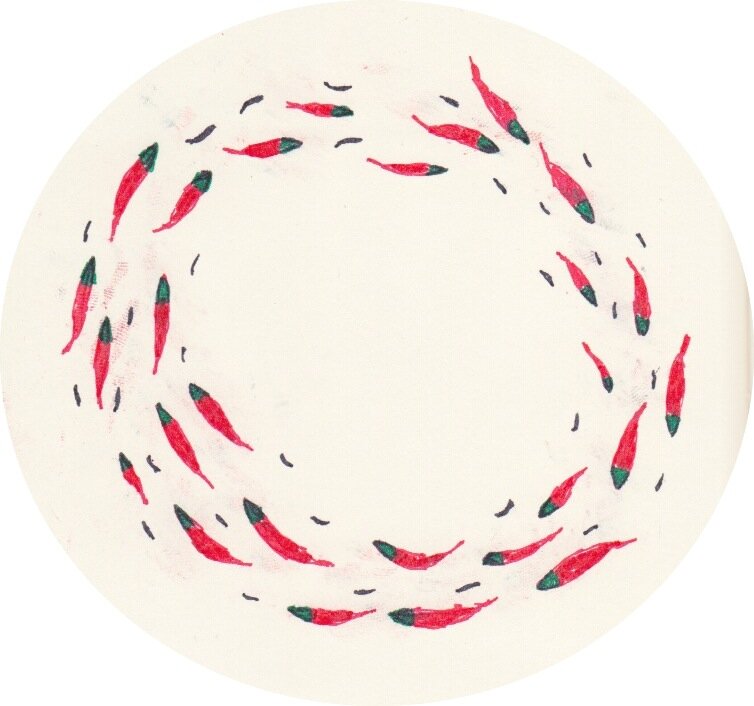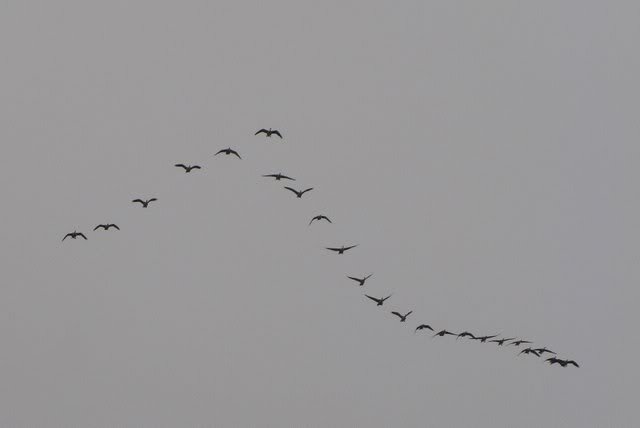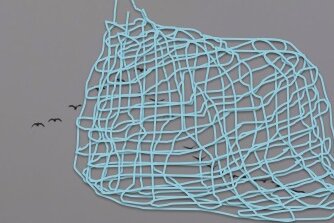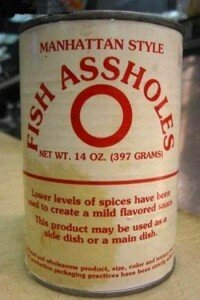So let me ask you this: What happened to Rivers Inlet sockeye?
Rivers Inlet is a large inlet located on mainland BC a little ways north of Port Hardy off the northern end of Vancouver Island.

do you see the irony in this map?
Here’s a slide from a presentation by Rick Routledge at Simon Fraser University in Vancouver:
-
- Rivers Inlet — once #2 in BC sockeye catch
Yeah, Rivers Inlet used to be #2 in BC sockeye catch. Although there was a time in the early 1900s when the Skeena was higher… but those runs zonked sooner than Rivers and Smith Inlets.
In the same presentation, Routledge has this slide:
I do find it curious that since there was no data for “escapement” (potential spawners that reach the river) prior to 1951 — and as such we still call this a sockeye “returns” graph. But then, I suppose, a sockeye caught at the mouth of the inlet is still a “return”…
Key message here… a lot of fish were caught in Rivers Inlet in the early 1900s.
A similar slide to a DFO report in 1998 by McKinnell and company: . (here we are looking for a “cause” again… separate from ourselves)
The numbers don’t really seem to match up between the slides… For example, the big catch year in 1926 shows almost 2 million fish caught in Routledge’s graph and maybe about 1.7 million in the DFO produced graph…
-

- Graph comparison
But gee whiz… what’s 200,000 to 300,000 fish caught in the heyday anyways…?
(or maybe it’s just the skewing due to scale…)
But why was there never a judicial inquiry into the collapse of Rivers Inlet sockeye — once the #2 commercial sockeye producing area?
And might those two huge years of catch in the 1970s have anything to do with the crash?
_ _ _ _ _ _ _
Hmmm…
so what do we have here?
Well… let’s consider a couple of things…
Firstly, if we take both of these graphs back far enough into the 1800s we would see a trend like this:

familiar trend?
And I think this may look familiar to many people.
It’s sort of a similar trend to many industrial fisheries around the world over the last 100-years or so…
For the economists out there it also sort of resembles the tax curve…
e.g. taxes are good for awhile but eventually they start to have negative returns and we see this classic mound shape…
Or for the cooks out there: the salt curve… A bit of salt is good, better to a point, then there are quickly dwindling returns on the taste front…
Or salmon cannery production… one cannery is decent, production goes up, profit goes up…

Rivers Inlet cannery (early 1900s?)
…throw in a couple more canneries

another Rivers Inlet cannery
…and eventually things plateau, populations start declining, production declines, profits decline… and CRASH!…

Was it worth it?
(and unfortunately, we can’t cut the costs of production by outsourcing to a place like China or otherwise… the classic economic solution)
_ _ _ _ _ _
Secondly, there is a classic western-science based assumption in all of this…
The idea that no one else was harvesting fish — commercially or otherwise — prior to the mid-1800s.
The common colonial concept of: the Latin expression for “no man’s land”; nobody here – nobody there.

Terra nullius & Mare nullius
Mare nullius is the ocean equivalent — “nobody was using the ocean…”
Almost every graph one looks at in the ‘science’ world shows this bizarre assumption that no salmon were being harvested prior to contact.
Why is that?
We know that entire cultures harvested millions upon millions of salmon. The bulk of First Nation cultures of BC are basically built upon the backs of salmon.
Some research suggests that the First Nation harvests of salmon pre-contact may actually have been higher than average commercial catches in previous decades.
So, why is there no big research agenda directed at finding just how many salmon were being harvested pre-contact? (appears it was done sustainably as the cultures thrived…)
Or how many salmon were being harvested by First Nation communities at the same time as the cannery boom? (granted most communities were forced from their fishing grounds and through this process basically formed the present landscape of the First Nation reserve system…)
Why is this not on the Cohen Commission research agenda?
Oh right… because we’re only looking at the 2009 Fraser River sockeye crash and nobody wants to admit that overfishing is one of the biggest culprits… because that would mean it’s our fault, us humans… much easier to blame ocean conditions, climate change, and so on and so on.
Sort of like the insurance industry that has outs with ‘acts of god’… for things like building on the floodplain of huge rivers and having dikes fail that were built to withstand the 1 in 100 flood year. (certainly wasn’t our fault for building in the floodplain in the first place… because really, how much comfort is there building in a place called “delta”?)
_ _ _ _ _ _
A key point here is that people are an intimate component of the salmon cycle — pretty much always have been; always will be.
And yet, when it comes to research agendas… judicial inquiries… salmon think tanks… and otherwise — we so often want to focus on the other ‘reasons’ for declines: ocean conditions, marine survival, juvenile migration, gravel condition, nursery lakes, etc.
(oddly enough though, we often don’t even focus on some of these basic components…e.g. DFO only really looks at 2 sockeye nursery lakes in the entire Fraser system)
Seems, we just don’t want to look in a mirror… and look back.
Might a look in the mirror clearly demonstrate the reason why Rivers Inlet sockeye have gone the way of the North Atlantic Cod?
Or why so many other BC sockeye and other salmon populations are on a similar path, or already well down that path…?
(Pretty much the only reason the Skeena River has sockeye anymore is because of massive enhancement and human-made spawning channels in the Babine system — which accounts for approximately 90% of the total Skeena return)
Is there an example of any wild animal population anywhere that is subject to industrial economic models over the last 100 years that has survived to tell a tell of plenitude and plenty and true long-term sustainability?
If we know that the decaying carcasses of spawned out adult salmon are key food for future generations of salmon; are key ingredients for the health of the surrounding environment (e.g. forest); and are key to the health of us-humans — then why do we continue to follow the route that we do?

Rivers Inlet canned salmon
All the fish in these cans means that consumption of nutrients is largely limited to humans in places a long ways away from the salmon’s natal stream… and what percentage of the sockeye runs to Rivers Inlet are represented in these cans — 80%, 90%, 98.5%…?
This means less nutrients for everything around and in the stream… which in turn means a dwindling cycle…
Why are we so damn blind to the impacts of the last 125 years (approx. 30 salmon life cycles)?
Doesn’t really matter where you look, the population trends of wild fish and humans over the last 150 years or so… tend to be on disparate angles.

humans and fish
I’m just not so sure the mystery is all that great…
Yet we continue to spend small fortunes on “research agendas” and “action plans” and “inquiries” to prove something we probably already know… e.g., we took far too many fish in the heyday, and now we’re paying the price.
The cod story is not a mystery… so why is the sockeye story expected to be much different?
And now the question is how many ‘interventions’ are we going to continue to muddle with? (stay tuned for next post)
_ _ _ _ _ _ _ _ _ _ _ _ _ _ _ _ _ _ _ _ _ _ _ _ _ _
Update from April 14th.
Related… came across this in one of Raincoast’s reports:
page 15









 Wow, sounds like a great investment opportunity…?!?!
Wow, sounds like a great investment opportunity…?!?!




























